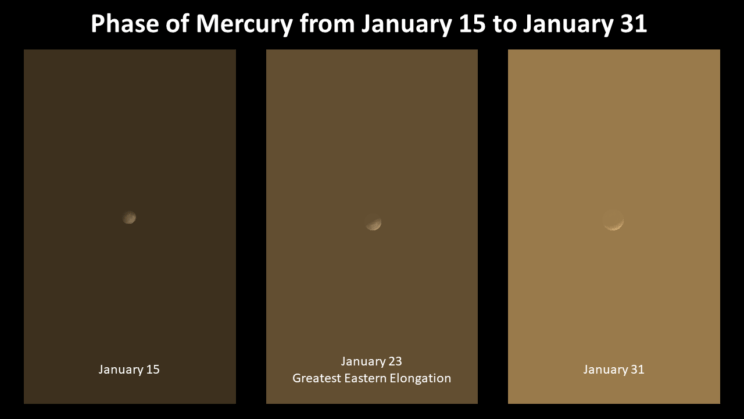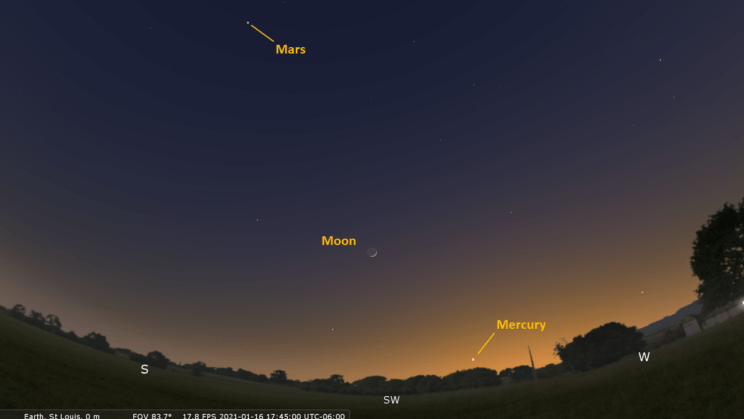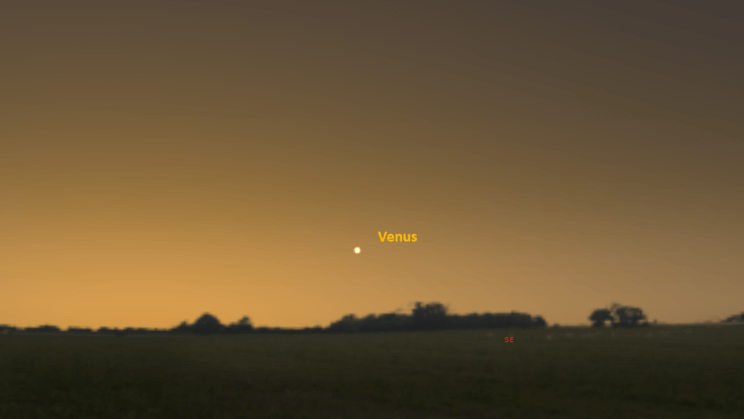This is the Saint Louis Science Center’s NIGHT SKY UPDATE for the week of Friday, January 15, 2020.
Information updated weekly or as needed.
Times given as local St. Louis time which is Central Standard Time (CST). For definitions of terminology used in the night sky update, click the highlighted text. If relying on times posted in Universal Time (UT), St. Louis is now -6 Hours from UT.
Public Telescope Viewings
Star parties at the Saint Louis Science Center have temporarily been canceled due to recommendations from the CDC regarding COVID-19. All public telescope events are canceled until further notice. As conditions change, we will reevaluate and update this article once public observing events resume.

Phase of Mercury January 15-31, 2020 Looking Southwest at 5:40 pm
Credit: Stellarium, EG
Observing Highlight of the Week
Mercury this week is starting one of its evening apparitions for 2021. From now until the end of January we can look forward to seeing the elusive planet about 40 minutes after sunset. The major challenge with observing Mercury is it never strays far from the Sun for our perspective on Earth. Therefore, we only see Mercury just after sunset or just before sunrise. This behavior helps define Mercury as an inferior planet and it is why sometimes you may find people calling Mercury an evening or morning star. It is important to note that the names Morning and Evening Star come from ancient times and are not indicating Mercury or Venus are stars.
Another feature of inferior planets is they exhibit a wide range of phases. Because Mercury is coming from behind the Sun when we see it start an evening apparition, through a telescope it exhibits a gibbous phase. Mercury will continue to exhibit a gibbous phase until January 23 as it reaches a point called maximum eastern elongation. This is when Mercury will be easiest to see as it will appear at its greatest distance from the Sun for this apparition. Through telescopes you will see Mercury in a quarter phase. After January 23, Mercury will start heading back towards the Sun as it moves towards inferior conjunction (passes between Earth and Sun) on February 8. As we approach this date the phase of Mercury transitions to a crescent.
Our short window to observe Mercury is due to the planet orbiting the Sun in 88 days. For one year on Earth, Mercury completes 4.14 orbits of the Sun. Planets closer to the Sun must move faster to stay in orbit. Neptune by comparison has an orbit that takes 164 years to complete and the dwarf planet Pluto takes an incredible 248 years to orbit the Sun. Learn more about Mercury at https://solarsystem.nasa.gov/planets/mercury/overview/
The Sun and Moon

The Moon as seen from the International Space Station, on July 31, 2011.
Credit: NASA
Sunrise is at 7:17 a.m. on Friday, January 15 and sunset is at 5:04 p.m. providing us with about 10 hours of daylight. Even after sunset, the light from the Sun will dimly illuminate our sky for about 1 hour and 30 minutes. This period is called twilight, which ends around 6:38 p.m. this week. For those with a sundial, local noon occurs around 12:11 p.m. this week.
| Day | Sunrise | Sunset |
|---|---|---|
| 2021-01-15 | 7:17 a.m. | 5:04 p.m. |
| 2021-01-16 | 7:17 a.m. | 5:05 p.m. |
| 2021-01-17 | 7:16 a.m. | 5:06 p.m. |
| 2021-01-18 | 7:16 a.m. | 5:07 p.m. |
| 2021-01-19 | 7:15 a.m. | 5:08 p.m. |
| 2021-01-20 | 7:15 a.m. | 5:09 p.m. |
| 2021-01-21 | 7:14 a.m. | 5:11 p.m. |
| 2021-01-22 | 7:14 a.m. | 5:12 p.m. |
| 2021-01-23 | 7:13 a.m. | 5:13 p.m. |
Moon
Moonrise for Friday, January 15 occurs at 09:18 a.m. and moonset will occur at 7:49 p.m. On Friday, January 15 the Moon will exhibit a waxing crescent phase with 9% of the lunar disk illuminated. First quarter moon occurs on January 20 at 3:02 p.m.
International Space Station (ISS) Observing

Visible passes of ISS from St. Louis for the week of January 15 occur during evening hours. The best passes this week occur on the evenings of January 17, 19 and 20. Use the table below for information about these and other visible passes this week.
Catch ISS from St. Louis starting Friday, January 15
| Date | Starts | Max. altitude | Ends | |||||||
|---|---|---|---|---|---|---|---|---|---|---|
| Time | Alt. | Az. | Time | Alt. | Az. | Time | Alt. | Az. | ||
| 16 Jan | -1.2 | 19:24:32 | 10 | SW | 19:25:37 | 19 | SW | 19:25:37 | 19 | SW |
| 17 Jan | -3.4 | 18:37:00 | 10 | SSW | 18:40:12 | 45 | SE | 18:40:17 | 45 | SE |
| 18 Jan | -2.4 | 17:49:46 | 10 | S | 17:52:34 | 25 | SE | 17:54:51 | 13 | E |
| 18 Jan | -1.4 | 19:26:08 | 10 | W | 19:27:49 | 23 | W | 19:27:49 | 23 | W |
| 19 Jan | -3.3 | 18:38:07 | 10 | WSW | 18:41:25 | 56 | NW | 18:42:18 | 40 | NNE |
| 20 Jan | -3.8 | 17:50:18 | 10 | SW | 17:53:39 | 82 | SE | 17:56:43 | 12 | NE |
| 20 Jan | -1 | 19:28:27 | 10 | WNW | 19:29:40 | 15 | NW | 19:29:40 | 15 | NW |
| 21 Jan | -1.9 | 18:40:02 | 10 | W | 18:42:50 | 23 | NNW | 18:44:00 | 19 | N |
| 22 Jan | -2.5 | 17:51:48 | 10 | W | 17:54:54 | 34 | NNW | 17:58:02 | 10 | NE |
| 23 Jan | -1.3 | 18:42:36 | 10 | NW | 18:44:25 | 14 | NNW | 18:45:25 | 12 | N |
Magnitude (Mag): The Measure of brightness for a celestial object. The lower the value is, the brighter the object will be.
Altitude (Alt): The angle of a celestial object measured upwards from the observer’s horizon.
Azimuth (Az): The direction of a celestial object, measured clockwise from an observer’s location with north being 0°, east being 90°, south being 180° and west being 270°.
For information about ISS flyovers and other visible satellites, visit www.heavens-above.com
Detailed information regarding all unmanned exploration of our universe, missions past, present, and planned, can be found at Jet Propulsion Laboratories:
The Visible Planets

Looking Southwest, at 5:45 pm, January 16, 2020
Credit: Stellarium, EG, WS

Looking Southeast, 7:00 am, January 17, 2020
Credit: Stellarium, EG
This week, three naked eye planets are visible. Mercury is found in the southwest and Mars is found high in the south after sunset. Venus can be found in the eastern sky before sunrise.
Mercury
Mercury is exhibiting its first evening apparition of 2021. The elusive planet will become easier to see as the week progresses. As Mercury heads towards greatest eastern elongation on January 23 the planet will be seen higher above the southwest horizon each night. Head outside about 40 minutes after sunset and look to the southwest to locate this elusive planet.
Venus
Venus rises at 6:16 a.m. and will be tough to see around 6:50 a.m. Venus remains a morning object until March 26, 2021 when it reaches superior conjunction. Since Venus has passed greatest western elongation, it is exhibiting a gibbous phase as it heads towards superior conjunction.
Mars
Currently Mars appears as a 0.1-magnitude object that will be visible high in the south about 30 minutes after sunset. Mars sets by 1:10 a.m. We are still near enough to Mars that surface features are visible through telescopes. Earth is moving away from Mars which means Mars is getting fainter each night. The observing season for this apparition ends around March 10, 2021 and superior conjunction occurs on October 7, 2021.
Uranus
Uranus is not a planet we normally include in this section. Even at its dimmest, the giant planet does hover within naked eye visibility. That said, it is so close to the visible limit of the human eye it just is not reality for most of us to see Uranus without binoculars or a telescope. You can find Uranus in the constellation Aries the Ram. The current magnitude for Uranus is 5.8. A finder chart for Uranus can be found here.
James S. McDonnell Planetarium
Night Sky Update: January 15-January 23, 2020






